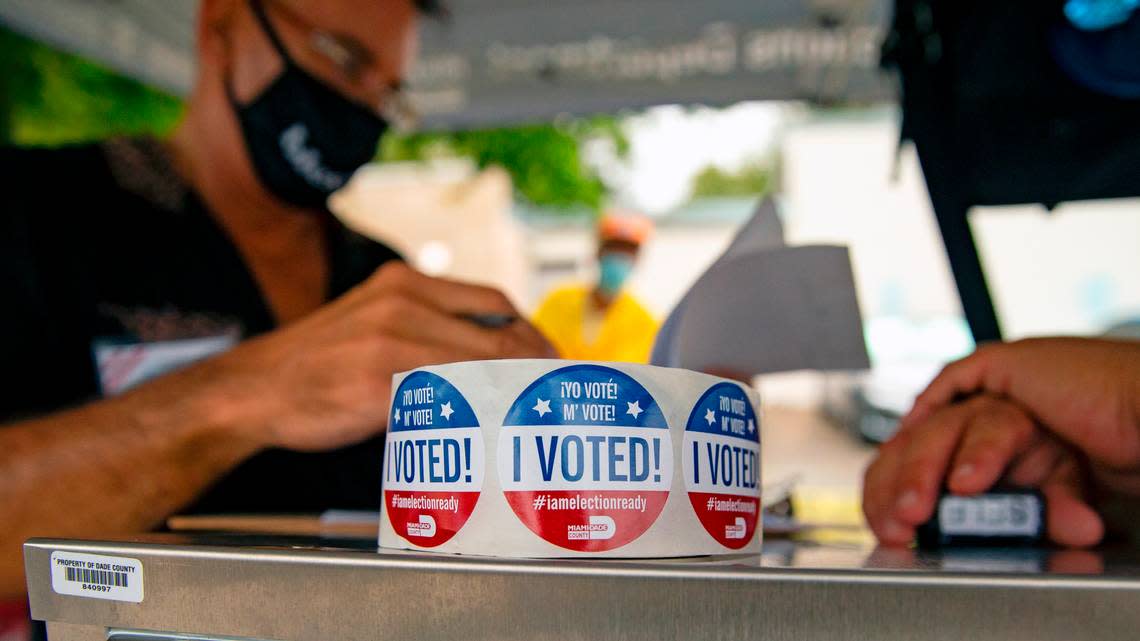As Florida eclipses 2016 early vote totals, Democratic turnout lags in Miami-Dade

With one week to go before Nov. 3, Florida has already surpassed its pre-Election Day voting totals from 2016.
On Tuesday, as voters continued streaming into early voting sites and elections officials tallied new mail ballots, the state blew past the 2016 total of about 6.6 million votes cast before Election Day, thanks in large part to a record 3.9 million mail ballots processed so far. A total of almost 6.8 million ballots had been cast in Florida by late Tuesday.
But while statewide turnout has been impressive, turnout in Miami-Dade County — among Democrats in particular — has been lagging somewhat. Entering Tuesday, about 45% of all registered voters in Florida had cast ballots, including 51% of Democrats, 46% of Republicans and 34% of independents, according to the U.S. Elections Project.
In Miami-Dade, where mail ballots went out on the last possible day, the turnout was less than 46% of registered voters Tuesday, state data shows. That includes 52% of Republicans, 47% of Democrats and 37% of independents.
Democrats still had about an 80,000-vote advantage over Republicans in Florida’s largest county, where about 41% of all registered voters are Democrats versus 27% Republicans. But experts say Democratic presidential candidate Joe Biden will need a substantial margin of victory in Miami-Dade to ultimately win Florida and potentially sink President Trump’s chances at reelection.
“The bad news: GOP turnout rates are higher than Democrats [in Miami-Dade],” Florida Democratic strategist Steve Schale, who led Barack Obama’s winning 2008 Florida campaign, wrote in a blog post Tuesday. “The GOP machine is very good in Miami — and particularly in the Cuban community, there is a real effort to get people to vote by mail and vote early.”
Schale said the data doesn’t “overly worry” him, noting that Democrats in Miami-Dade “tend to catch up over time.” But he added: “I would like to see turnout increase — and yes, we need improvement.”
I’m concerned about Democratic turnout in Miami-Dade. This is an evergreen concern, but still.
— Kevin Cate (@KevinCate) October 27, 2020
Steve Simeonidis, the chair of the Miami-Dade Democratic Party, told the Miami Herald he is “cautiously optimistic” about where things stand. He emphasized recent poll numbers that suggest independent voters in Miami-Dade prefer Biden to Trump.
In an early October poll of 600 likely voters by Bendixen & Amandi International and the Miami Herald, 62% of independents rated President Trump as unfavorable versus 33% favorable, while 37% of independents gave Biden an unfavorable rating versus 55% favorable.
Simeonidis said about 30,000 independents in Miami-Dade registered to vote in the five months before this year’s deadline. “Those without party affiliation are going to vote for Biden by a two-to-one margin,” he predicted.
He added that he expects a second “Souls to the Polls” event this Sunday to lead to a big Democratic turnout in Miami-Dade on the final day of in-person early voting. Republicans across Florida have been outnumbering Democrats at in-person early voting sites so far, including by about 5,000 votes in Miami-Dade.
“The Democrats have a large lead in Miami-Dade, but it’s nothing compared to the lead we’re going to need to have to win the state,” Simeonidis said. “We’re not where we need to be right now.”
Nelson Diaz, the chair of the Miami-Dade Republican Party, said he’s not surprised Republicans are showing up to vote early.
“There’s a lot of Republicans that it’s not hard to motivate them to go vote, especially in Miami-Dade,” Diaz said. He pointed out that, on Monday, Republicans across Florida cut into Democrats’ overall vote lead by over 50,000 votes, thanks to in-person turnout — a reversal from previous elections in which Republicans came out stronger in absentee voting and Democrats had the early, in-person edge.
“That’s flipped. Republicans are slowly chipping away,” he said.
So many Republicans have turned out that, as of Tuesday morning, relatively few were left to vote. The roughly 210,000 Republicans who had yet to vote made up about 24% of the 852,000 Miami-Dade voters who’d yet to cast a ballot in the election, raising the likelihood that much of the remaining vote to come in through Election Day will be cast by Democrats and independents.
In 2016, Trump rode big Election Day numbers to win Florida, even as Democratic nominee Hillary Clinton outperformed him in Miami-Dade, 63% to 34%. Four years earlier, Barack Obama won the state by less than one percentage point after he won Miami-Dade, 62% to 38% over Mitt Romney, a smaller margin than Clinton’s 2016 victory in the county.
Experts seem to agree on a few things: first, that Miami-Dade voting patterns can be unpredictable. The county, wrote Schale, is “basically a riddle, wrapped in a mystery, inside an enigma.”
Additionally, experts note that, in a year where typical voting patterns have been turned upside down by the COVID-19 pandemic, it’s hard to make predictions about who will win the state.
Ultimately, many say, Florida’s presidential race is a toss-up — just like in so many past elections.
“Florida’s early vote is sending a confirming signal the state will be close,” Michael McDonald, a University of Florida professor who runs the U.S. Elections Project, tweeted Tuesday.
Dave Wasserman, an elections expert who edits the Cook Political Report, concurred.
“FL’s early vote data tells us virtually nothing about the vote preferences of the final electorate,” Wasserman tweeted. “We do have plenty of other evidence, however, that the state will be close.”
FL's early vote data tells us virtually nothing about the vote preferences of the final electorate. We do have plenty of other evidence, however, that the state will be close. https://t.co/LvRRx7Bv2D
— Dave Wasserman (@Redistrict) October 27, 2020
Herald staff writer David Smiley contributed to this report.

